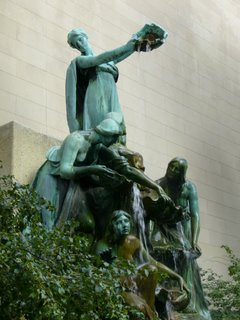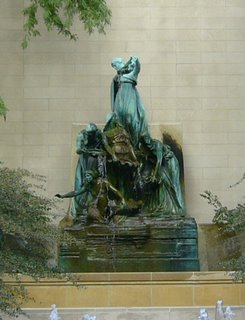Another day at the Museum

where someone has turned to the next page of "Oriental Field Sports"
by Captain Williamson

Though, I'm not sure that the artist, Samuel Howitt, was quite as familiar with elephants and tigers as he was with horses and pigs.
My next destination was the Vollard exhibit -- but I never got there
---( the waiting line was way too forbidding )---

So instead I visited the Japanese rooms -- to meditate on the distinction between
the Heian era (very important to fans of Lady Murasaki)
--and the Kamakura era that followed it ( very important to those who like Samurai movies)
The above is an iconic Kamakura piece by Unkei and Kwaikei (still found in Japan)

while this piece -- and the others that follow are now in Chicago.
The difference seems pretty drastic here, doesn't it ?
The Heian guardian looks strong -- but he's hardly forbidding,
while I can't imagine any thing , living or dead, that wouldn't run in terror from
the Kamakura piece if it began to move

But.. what about this piece ?
-- which is also Kamakura but oh-so-quiet
maybe .. it's too quiet ....
 compared, say to this one ?
compared, say to this one ?Well... that's my explanation anyway.
The Heian piece just feels a little more natural -- like a tree or natural feature
while the Kamakura seems more devoted to a specific purpose like
"I have come to save you from the terrible world"
 Here's another Heian piece...
Here's another Heian piece...these things are sooooo relaxing..
like stumbling across a waterfall in the forest

and now for further comparison --- here's a Nara period piece in the same room
(Nara being the capital in the few centuries before the building of Kyoto)
This was the time when Chinese civilization was adopted
..and doesn't this fellow seem to be saying:
"I have come with the Truth"
 Well.. moving onto something completely different -- I shot this Turkish dagger (1800-1900)
Well.. moving onto something completely different -- I shot this Turkish dagger (1800-1900)
..because I knew Gawain would like to see its ornate detail
(and I really like those clusters of jewels)

Which is the same reason I shot this Indian mirror
..it's just too gorgeous (especially with that tiny rupee that perched on top)
(and I'd love to daydream about the faces that once were looking into its other side)
 Finally -- yet again in tribute to Sir Gawain --
Finally -- yet again in tribute to Sir Gawain --I found these
Seven sages of the Bamboo Grove
by Yashima Gakutei, c. 1825
Apparently in imitation of the 4 sages of Mount Shang,
these seven wise individuals fled from the evil Cao Cao's Kingdom of Wei
(i.e. in the time of the "Romance of the Three Kingdoms")
to look at scenery, make word games , write poetry, play music, and generally do all the things thatGawain thinks his friends should be doing.
(regretfully, one of them, Xi Kang, was executed for "immoral behavior" (i.e. excessive blogging) in 262
The poem in the above depiction was translated as follows:
With the arrival of spring
wise men stop in their tracks
a bush warbler disporting
in the bamboo grove
No matter how wise
in the spirngtime capital
fresh young bamboo
in Yuanji's eyes
Labels: Art Institute of Chicago












































